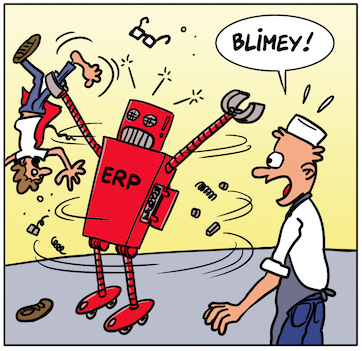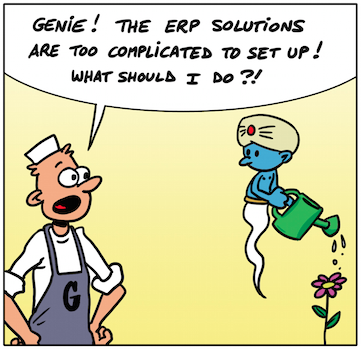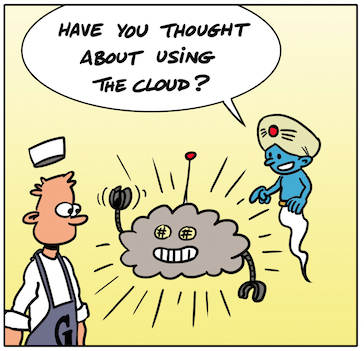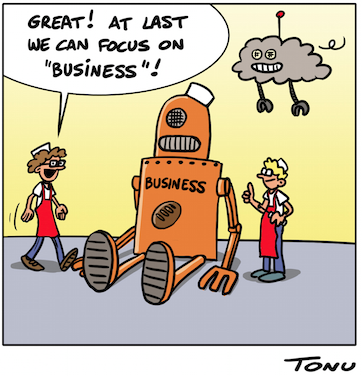Installing a software package is generally more
complicated than anticipated.
We have to configure the software, install the IT hardware,
test, optimize the performances, train the operating systems
team, manage upgrades, adapt the configuration to the workload...
The Cloud is one way of simplifying the life of the Enterprise by
transferring these concerns to the supplier: not only does the
software used belong to the external supplier, but operating it
is managed externally, which enables its use to be
commercialized as on-demand or subscription-based consumption,
and not as a license.
- The requirements of the Cloud will increase the quality of the software operated
- Using Cloud Solutions will foster simplicity: the supplier delivers some part of the support, it is its own interest to reduce the number of calls
- Service quality can only grow: contracting a « SLA » (Service Level Agreement) pressures the supplier into assuring a high level of service if he does not want to loose its Customer or impact his reputation
- Enterprises will be a lot more agile when it comes to installing new Solutions
- Small Enterprises will be able to acquire modern, affordable Solutions
- The Cloud will help the extended Enterprise to function by integrating not only its staff but also its partners and customers into the shared Processes
- The Cloud will promote mobility and innovative forms of organization
- The Cloud will enable us to imagine Solutions that
were not possible before.
- How do we ensure the protection of the data that is "elsewhere"?
- How can we accept a standard Solution that we cannot modify, especially when it automates the core of the business?
- How do we integrate "SaaS" Solutions without increasing the complexity of the Enterprise Model?
- How do we adapt our organization and share out the roles
between Business and IT?
-
- How do we strengthen the role of the architects to evaluate the quality and integrate Cloud services into the Enterprise Model?
- How do we increase the configurators' role at the expense of the developers'?
- How do we manage the disappearance of the IT operators of the Enterprise?
- How do we make the role of quality manager for service and security emerge?
- How do we control new contractual practices and correctly
plan for the SaaS Solution release?
- large traditional Vendors may disappear if they do not convert to SaaS
- Software Vendors will have to be much more rigorous about their product quality
- the size of Business Software Vendors will increase in order to meet more important investments than a software package for large vertical applications, and will coexist with a multitude of tiny vendors for autonomous applications
- Integrators will see their market shrink as specific developments will be limited: they will reconvert to configuration and interface building work to make the Cloud Solutions and existing Solutions coexist, as well as Data migration
- BPO Suppliers will grow: the economies of scale generated by the SaaS Model will see them become more competitive
- Infrastructure Suppliers will become increasingly powerful to facilitate scalability: they will become the main buyers of IT hardware suppliers. They will act as the large supermarkets were able to do with their suppliers. Some (like Google) will even be able to assemble their own servers from components bought directly.
- Consulting companies will have to be able to advise their customers so that they benefit from Cloud offers in their business.
The Cloud accompanies the generalization of agile Approaches and the
continuous development of highly configurable off-the-shelf
solutions, with few specific developments, and more minor but
more frequent developments than for historical software
packages. Cloud projects bring faster results more cheaply,
minimizing the risks of failure (and associated cost) and
enabling the gradual building of solutions with an increasingly
wide scope.
- A good configuration capability: the same Solution is exploited by many customers who must be able to personalize it to their needs through configuration and not through specific development
- A good integration capability (both between Clouds and with the internal IS) thanks to rich and stable APIs
- A good evolution capability which requires a sound Architecture base and
a process of continuous development
- Evaluate: the enterprise should carry out active monitoring to judge the quality and security of the Cloud solutions. During an implementation project, it must audit the development, evolution and operation capabilities of the Solution by the supplier. It must also identify the type of contract proposed and the level of negotiation possible.
- Decide: the Enterprise must evaluate itself regarding its maturity faced with the Cloud, know the existing setup, the initial costs, know the level of criticality of the solution to be built, build a business case and check the quality of the solution proposed and the reliability of the supplier
- Implement: the Enterprise should be aware that the implementation has to go mainly through configuration and that the requirements must be simple and prioritized. Implementation is generally iterative and goes through configuration rather than specific development. An important part concerns data migration and integration with the existing setup which is only possible if the solution provides good APIs.
- Deploy: Deployment can be made easier thanks to a simple and user-friendly interface and an international access thanks to the Internet. But, the need to give up on certain Enterprise specificities to align oneself with the standard of the SaaS solution may entail a significant change management.
- Operate: The governance of the services in production must
be prepared in the implementation project and include precise
supervision of the service performance indicators. The vendor
exploiting the solution moves closer to their customers and
the role of service manager becomes professionalized.
- Terminate: The end of contract should be planned when the
the contract is first signed with the conditions of data
recovery (format and timescale). This point should also be
reviewed each time the service evolves.
The Cloud appears as a heavy trend, the culmination of the
gradual evolution of technologies and practices, that will
profoundly renew the roles of all the actors of the ecosystem,
as much in the enterprises using the Cloud as at the suppliers.
In the choice and implementation of solutions, it strengthens
the role of the enterprise architect, who is the conductor of
the building and evolution of an agile IS, and who knows how to
leverage the full potential of this new mode of making IT
resources and software available.
See the white paper from CEISAR

The story of George the Baker is made available under the terms of the
Creative Commons Attribution - NoDerivatives 4.0 International license.



